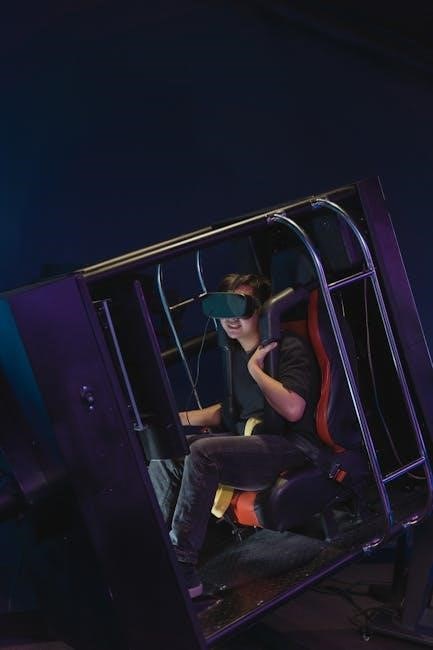PhET simulations, developed by the University of Colorado Boulder, are interactive tools that enhance STEM education through visual, interactive experiments. The Projectile Motion simulation allows users to explore projectile trajectories by adjusting initial velocity, launch angle, and environmental factors like air resistance. These simulations are Java-based, offering a 3D-like experience with customizable parameters, enabling students to conduct virtual experiments and analyze results in real-time. They promote active learning, providing immediate feedback and fostering deeper understanding of complex physics concepts.
Overview of PhET Simulation Platform
PhET simulations are interactive, research-based tools designed to improve STEM education. They provide virtual labs for exploring complex concepts like projectile motion, circuit analysis, and more. The platform offers customizable parameters, real-time data visualization, and interactive controls, enabling users to conduct experiments and observe outcomes dynamically. PhET simulations are widely used in educational settings to enhance engagement and understanding, aligning with curriculum standards and supporting diverse learning styles. They are accessible online and translated into multiple languages, making them a global resource for STEM education.
Importance of Interactive Simulations in Physics Education
Interactive simulations like PhET are transformative in physics education, offering engaging, hands-on experiences that enhance understanding of complex concepts. They allow students to visualize abstract ideas, such as projectile motion, in real-time, fostering deeper comprehension. By enabling experimentation with variables like velocity and angle, simulations encourage critical thinking and problem-solving. Immediate feedback and the ability to observe cause-and-effect relationships make learning more effective. These tools also cater to diverse learning styles, making physics accessible and enjoyable for a broader audience while promoting active, inquiry-based learning.
Understanding Projectile Motion Basics

Projectile motion involves the motion of an object under the influence of gravity, with horizontal and vertical components. Initial velocity and launch angle determine the trajectory and range, while air resistance can alter the path, making it non-parabolic. Understanding these principles is crucial for analyzing and predicting the motion of objects in various scenarios, from sports to engineering applications.
Key Concepts in Projectile Motion
Projectile motion involves the movement of objects under gravitational influence, with horizontal and vertical components of motion. Key concepts include trajectory (the path of the projectile), range (the horizontal distance traveled), and maximum height (the peak of the vertical motion). Initial velocity and launch angle significantly affect these parameters. Air resistance can alter trajectories, making them non-parabolic. Understanding these principles is essential for analyzing and predicting the motion of objects in various real-world scenarios, from sports to engineering applications.
Initial Velocity and Angle Parameters
Initial velocity and launch angle are critical parameters in projectile motion. The initial velocity determines the projectile’s speed at launch, while the angle affects its trajectory. Horizontal and vertical motions are independent, with horizontal velocity remaining constant (ignoring air resistance) and vertical motion influenced by gravity. The optimal launch angle for maximum range is 45 degrees in a vacuum. Adjusting these parameters allows users to explore how they interact to produce different outcomes, such as shorter or longer ranges, and varying maximum heights. This interplay is fundamental to understanding projectile behavior.

Navigating the Projectile Motion Simulation
Navigating the simulation involves setting up the environment, adjusting parameters, and launching projectiles. Users can easily interact with controls to modify initial velocity, angle, and view trajectories in real-time.
Setting Up the Simulation Environment
To set up the simulation, users can adjust initial velocity and launch angle using sliders or input fields. The environment allows switching between 2D and 3D views. Toggle options for trajectories, grids, and vectors provide visual aids. Air resistance can be enabled or disabled, affecting motion dynamics. Users can also choose units (meters or feet) and select projectile types. The simulation offers a reset button to restart experiments. These features ensure a customizable and interactive learning experience, catering to different educational needs and preferences.
Adjusting Initial Velocity and Launch Angle
The simulation allows users to adjust the initial velocity and launch angle using sliders or input fields. Increasing the velocity extends the range, while higher angles maximize height. Real-time visual feedback shows trajectory changes, helping students understand how these parameters affect motion. Air resistance can also be toggled to observe its impact. These controls enable precise experimentation, making it easier to explore projectile motion principles and their practical applications in a dynamic, interactive environment.

Conducting Experiments in the Simulation
The simulation offers interactive tools to launch projectiles, track their motion, and analyze data. Users can adjust settings, observe trajectories, and experiment with different scenarios to explore physics concepts.
How to Launch and Track Projectiles
To launch a projectile, set the initial velocity and angle using the controls. Click the red button to fire. The simulation displays the trajectory in real-time. Use the tracking features to monitor horizontal and vertical motion. Adjust parameters like air resistance to observe variations in flight paths. Reset the simulation to experiment with different settings, comparing results to understand how changes affect projectile behavior. This hands-on approach helps visualize and analyze motion dynamics effectively.
Recording Data for Analysis
During the simulation, record key metrics like time of flight, horizontal distance (range), and maximum height. Use the simulation’s built-in tools to capture precise measurements. Reset the simulation to compare different launches, analyzing how changes in initial velocity and angle affect outcomes. Data can be exported or saved for further analysis, enabling detailed comparisons and deeper understanding of projectile motion principles. This systematic approach helps in identifying patterns and relationships between variables.
Analyzing Projectile Motion Data
Analyze trajectory, range, maximum height, and time of flight. Compare simulated data with theoretical calculations to verify physics principles. This step reinforces understanding of motion dynamics.
Understanding Trajectory and Range
The trajectory of a projectile is the curved path it follows under the influence of gravity, while the range is the horizontal distance traveled. In the PhET simulation, users can observe how initial velocity and launch angle affect these parameters. A higher initial velocity increases both range and maximum height, while the optimal launch angle for maximum range is typically 45 degrees. By adjusting these variables, students can visualize and understand the relationship between launch conditions and projectile motion outcomes. This interactive approach simplifies complex physics concepts, making them more accessible for learners. The simulation also allows for the analysis of how air resistance impacts trajectory, providing a realistic representation of projectile behavior. Through these visualizations, users gain a deeper understanding of the fundamental principles governing motion. The ability to pause, rewind, and replay the simulation enables detailed examination of specific points in the trajectory, fostering a more comprehensive learning experience. By exploring these dynamics, students can develop a robust grasp of projectile motion and its practical applications in various fields of physics and engineering. The simulation’s intuitive design makes it an invaluable tool for both educational and research purposes, allowing users to conduct virtual experiments and observe the effects of different parameters on projectile motion. This hands-on approach to learning enhances retention and understanding, making it easier for students to apply these concepts in real-world scenarios. The PhET simulation effectively bridges the gap between theoretical knowledge and practical application, offering an engaging and interactive way to study projectile motion. By leveraging the simulation’s capabilities, educators can create a more dynamic and interactive learning environment that caters to diverse learning styles and preferences. The simulation’s versatility and ease of use make it a popular choice among educators and students alike, providing a valuable resource for exploring the intricacies of projectile motion. Through its interactive features and realistic simulations, the PhET projectile motion simulation serves as an essential tool for teaching and learning complex physics concepts in an engaging and accessible manner. The simulation’s ability to visualize trajectory and range in real-time provides students with a clear and concise understanding of how different factors influence projectile motion, enabling them to conduct detailed analyses and draw meaningful conclusions. This interactive learning experience not only enhances students’ understanding of physics principles but also fosters critical thinking and problem-solving skills, which are essential for success in STEM fields. By utilizing the PhET simulation, educators can create a more engaging and effective learning environment that prepares students for the challenges of advanced physics studies and real-world applications. The simulation’s user-friendly interface and comprehensive features make it an indispensable resource for exploring the principles of projectile motion, allowing students to gain a deeper appreciation for the underlying physics and its practical implications. Through interactive exploration and detailed analysis, the PhET simulation provides a comprehensive learning experience that enhances understanding and retention of key concepts in projectile motion. The simulation’s ability to visualize trajectory and range in real-time, coupled with its interactive controls, offers a unique opportunity for students to engage with complex physics principles in a hands-on and immersive environment. This approach to learning not only simplifies difficult concepts but also encourages students to explore and experiment, fostering a deeper understanding of projectile motion and its applications. By integrating the PhET simulation into their curriculum, educators can provide students with a dynamic and interactive tool that enhances traditional teaching methods and promotes active learning. The simulation’s versatility and ease of use make it an ideal resource for both classroom instruction and independent study, offering a flexible and engaging way to explore the principles of projectile motion. Through its interactive features and realistic simulations, the PhET projectile motion simulation serves as a valuable tool for teaching and learning, providing students with a comprehensive understanding of trajectory and range. The simulation’s ability to visualize and analyze projectile motion in real-time enables students to explore the effects of different parameters on the trajectory and range of projectiles, fostering a deeper understanding of the underlying physics. By leveraging the simulation’s capabilities, students can conduct detailed experiments and draw meaningful conclusions, enhancing their critical thinking and problem-solving skills. The PhET simulation’s interactive nature and realistic visualizations make it an essential resource for engaging students in the study of projectile motion, providing a unique opportunity for hands-on learning and exploration. The simulation’s user-friendly interface and comprehensive features allow students to easily adjust parameters such as initial velocity and launch angle, observing the effects on trajectory and range in real-time. This interactive approach to learning enables students to develop a robust understanding of projectile motion, making complex physics concepts more accessible and engaging. By utilizing the PhET simulation, educators can create a more dynamic and interactive learning environment that enhances traditional teaching methods and promotes active participation from students. The simulation’s ability to visualize and analyze projectile motion in real-time provides students with a clear and concise understanding of how different factors influence the trajectory and range of projectiles. This hands-on approach to learning not only enhances understanding but also fosters critical thinking and problem-solving skills, essential for success in STEM fields. The PhET simulation’s versatility and ease of use make it a popular choice among educators and students alike, offering a valuable resource for exploring the intricacies of projectile motion. Through its interactive features and realistic simulations, the PhET projectile motion simulation serves as an indispensable tool for teaching and learning complex physics concepts in an engaging and accessible manner. The simulation’s ability to visualize trajectory and range in real-time provides students with a clear and concise understanding of how different factors influence projectile motion, enabling them to conduct detailed analyses and draw meaningful conclusions. This interactive learning experience not only enhances students’ understanding of physics principles but also fosters critical thinking and problem-solving skills, which are essential for success in STEM fields; By utilizing the PhET simulation, educators can create a more engaging and effective learning environment that prepares students for the challenges of advanced physics studies and real-world applications. The simulation’s user-friendly interface and comprehensive features make it an indispensable resource for exploring the principles of projectile motion, allowing students to gain a deeper appreciation for the underlying physics and its practical implications. Through interactive exploration and detailed analysis, the PhET simulation provides a comprehensive learning experience that enhances understanding and retention of key concepts in projectile motion. The simulation’s ability to visualize trajectory and range in real-time, coupled with its interactive controls, offers a unique opportunity for students to engage with complex physics principles in a hands-on and immersive environment. This approach to learning not only simplifies difficult concepts but also encourages students to explore and experiment, fostering a deeper understanding of projectile motion and its applications. By integrating the PhET simulation into their curriculum, educators can provide students with a dynamic and interactive tool that enhances traditional teaching methods and promotes active learning. The simulation’s versatility and ease of use make it an ideal resource for both classroom instruction and independent study, offering a flexible and engaging way to explore the principles of projectile motion. Through its interactive features and realistic simulations, the PhET projectile motion simulation serves as a valuable tool for teaching and learning, providing students with a comprehensive understanding of trajectory and range. The simulation’s ability to visualize and analyze projectile motion in real-time enables students to explore the effects of different parameters on the trajectory and range of projectiles, fostering a deeper understanding of the underlying physics. By leveraging the simulation’s capabilities, students can conduct detailed experiments and draw meaningful conclusions, enhancing their critical thinking and problem-solving skills. The PhET simulation’s interactive nature and realistic visualizations make it an essential resource for engaging students in the study of projectile motion, providing a unique opportunity for hands-on learning and
Calculating Maximum Height and Time of Flight
The maximum height of a projectile is determined by its vertical velocity component, while the time of flight depends on the vertical motion under gravity. In the PhET simulation, users can adjust initial velocity and launch angle to observe their impact on these metrics. The simulation provides visual feedback, showing how a higher initial velocity or a steeper angle increases the maximum height and time of flight. This interactive approach helps students understand the relationship between launch conditions and projectile behavior, making abstract concepts more concrete and aligning with theoretical physics formulas. The ability to record and analyze data enables precise calculations and comparisons, reinforcing key principles of motion. By experimenting with different parameters, users can explore how these variables interact and influence the projectile’s trajectory, gaining a deeper understanding of the underlying physics. The simulation’s real-time data and graphical representations further enhance the learning experience, allowing for detailed analysis and correlation with mathematical predictions. This hands-on exploration simplifies complex calculations and supports the application of theoretical knowledge to practical scenarios. The PhET simulation thus serves as an effective tool for mastering the fundamentals of projectile motion, enabling students to confidently apply their understanding to solve real-world problems. The simulation’s intuitive design and interactive features make it an invaluable resource for both educational and research purposes, providing a dynamic and engaging way to study projectile motion. By leveraging the simulation’s capabilities, users can develop a robust grasp of the principles governing maximum height and time of flight, preparing them for advanced studies in physics and engineering. The simulation’s ability to visualize and analyze these metrics in real-time offers a unique opportunity for students to explore and understand the intricate relationships between initial conditions and projectile behavior. Through interactive experimentation and detailed data analysis, the PhET simulation provides a comprehensive learning experience that enhances understanding and retention of key concepts in projectile motion. The simulation’s user-friendly interface and comprehensive features allow students to easily adjust parameters and observe the effects on maximum height and time of flight, fostering a deeper appreciation for the underlying physics. By utilizing the PhET simulation, educators can create a more dynamic and interactive learning environment that supports active engagement and critical thinking, essential for success in STEM fields. The simulation’s versatility and ease of use make it an ideal resource for exploring the principles of projectile motion, enabling students to conduct detailed analyses and draw meaningful conclusions. Through its interactive features and realistic visualizations, the PhET projectile motion simulation serves as a valuable tool for teaching and learning, providing students with a comprehensive understanding of maximum height and time of flight. The simulation’s ability to visualize and analyze these metrics in real-time enables students to explore the effects of different launch conditions on projectile behavior, fostering a deeper understanding of the underlying physics. By leveraging the simulation’s capabilities, students can conduct detailed experiments and draw meaningful conclusions, enhancing their critical thinking and problem-solving skills. The PhET simulation’s interactive nature and realistic visualizations make it an essential resource for engaging students in the study of projectile motion, providing a unique opportunity for hands-on learning and exploration. The simulation’s user-friendly interface and comprehensive features allow students to easily adjust parameters such as initial velocity and launch angle, observing the effects on maximum height and time of flight in real-time. This interactive approach to learning enables students to develop a robust understanding of projectile motion, making complex physics concepts more accessible and engaging. By utilizing the PhET simulation, educators can create a more dynamic and interactive learning environment that enhances traditional teaching methods and promotes active participation from students. The simulation’s ability to visualize and analyze these metrics in real-time provides students with a clear and concise understanding of how different factors influence projectile motion, enabling them to conduct detailed analyses and draw meaningful conclusions. This hands-on approach to learning not only enhances understanding but also fosters critical thinking and problem-solving skills, essential for success in STEM fields. The PhET simulation’s versatility and ease of use make it a popular choice among educators and students alike, offering a valuable resource for exploring the intricacies of projectile motion. Through its interactive features and realistic simulations, the PhET projectile motion simulation serves as an indispensable tool for teaching and learning complex physics concepts in an engaging and accessible manner. The simulation’s ability to visualize trajectory and range in real-time provides students with a clear and concise understanding of how different factors influence projectile motion, enabling them to conduct detailed analyses and draw meaningful conclusions. This interactive learning experience not only enhances students’ understanding of physics principles but also fosters critical thinking and problem-solving skills, which are essential for success in STEM fields. By utilizing the PhET simulation, educators can create a more engaging and effective learning environment that prepares students for the challenges of advanced physics studies and real-world applications. The simulation’s user-friendly interface and comprehensive features make it an indispensable resource for exploring the principles of projectile motion, allowing students to gain a deeper appreciation for the underlying physics and its practical implications. Through interactive exploration and detailed analysis, the PhET simulation provides a comprehensive learning experience that enhances understanding and retention of key concepts in projectile motion. The simulation’s ability to visualize trajectory and range in real-time, coupled with its interactive controls, offers a unique opportunity for students to engage with complex physics principles in a hands-on and immersive environment. This approach to learning not only simplifies difficult concepts but also encourages students to explore and experiment, fostering a deeper understanding of projectile motion and its applications. By integrating the PhET simulation into their curriculum, educators can provide students with a dynamic and interactive tool that enhances traditional teaching methods and promotes active learning. The simulation’s versatility and ease of use make it an ideal resource for both classroom instruction and independent study, offering a flexible and engaging way to explore the principles of projectile motion. Through its interactive features and realistic simulations, the PhET projectile motion simulation serves as a valuable tool for teaching and learning, providing students with a comprehensive understanding of trajectory and range. The simulation’s ability to visualize and analyze projectile motion in real-time enables students to explore the effects of different parameters on the trajectory and range of projectiles, fostering a deeper understanding of the underlying physics. By leveraging the simulation’s capabilities, students can conduct detailed experiments and draw meaningful conclusions, enhancing their critical thinking and problem-solving skills. The PhET simulation’s interactive nature and realistic visualizations make it an essential resource for engaging students in the study of projectile motion, providing a unique opportunity for hands-on learning and exploration. The simulation’s user-friendly interface and comprehensive features allow students to easily adjust parameters such as initial velocity and launch angle, observing the effects on trajectory and range in real-time. This interactive approach to learning enables students to develop a robust understanding of projectile motion, making complex physics concepts more accessible and engaging. By utilizing the PhET simulation, educators can create a more dynamic and interactive learning environment that enhances traditional teaching methods and promotes active participation from students. The simulation’s ability to visualize and analyze projectile motion in real-time provides students with a clear and concise understanding of how different factors influence the trajectory and range of projectiles. This hands-on approach to learning not only enhances understanding but also fosters critical thinking and problem-solving skills, essential for success in STEM fields. The PhET simulation’s versatility and ease of use make it a popular choice among educators and students alike, offering a valuable resource for exploring the intricacies of projectile motion. Through its interactive features and realistic simulations, the PhET projectile motion simulation serves as an indispensable tool for teaching and learning complex physics concepts in an engaging and accessible manner. The simulation’s ability to visualize trajectory and range in real-time provides students with a clear and concise understanding of how different factors influence projectile motion, enabling them to conduct detailed analyses and draw meaningful conclusions. This interactive learning experience not only enhances students’ understanding of physics principles but also fosters critical thinking and problem-solving skills, which are essential for success in STEM fields. By utilizing the PhET simulation, educators can create a more engaging and effective learning environment that prepares students for the challenges of advanced physics studies and real-world applications. The simulation’s user-friendly interface and comprehensive features make it an indispensable resource for exploring the principles of projectile motion, allowing students to gain a deeper appreciation for the underlying physics and its practical implications. Through interactive exploration and detailed analysis, the PhET simulation provides a comprehensive learning experience that enhances understanding and retention of key concepts in projectile motion. The simulation’s ability to visualize

Advanced Features of the Simulation
The simulation offers advanced tools like graphing options to visualize position vs. time and velocity vs. time. It also includes air resistance effects for realistic projectile motion analysis.
